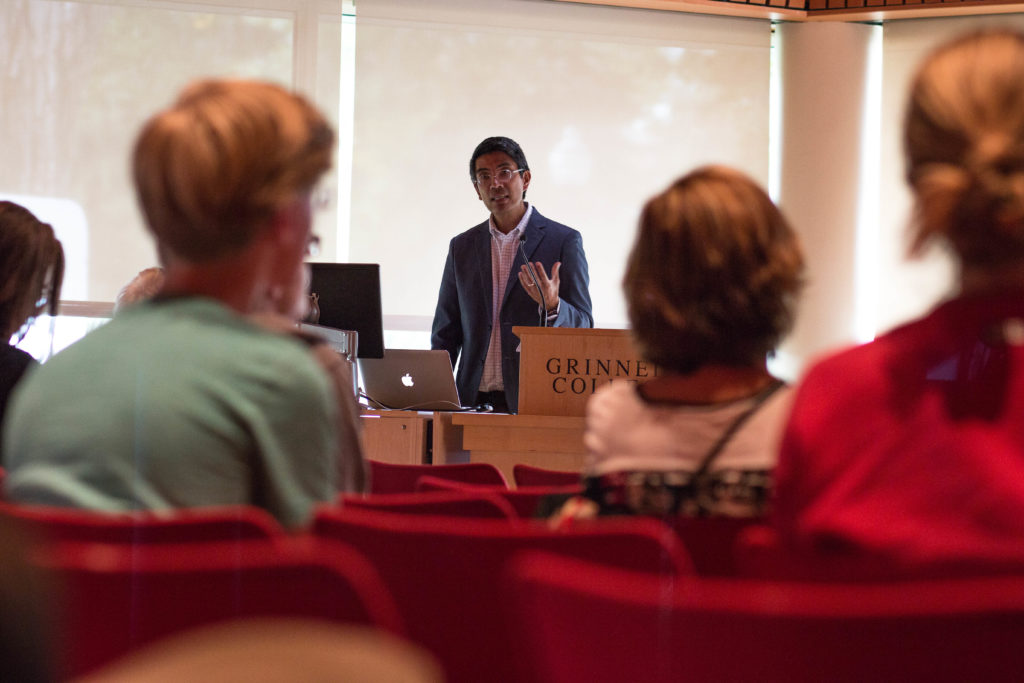By Amanda Weber
weberama@grinnell.edu
This week, the College hosted the symposium “Our Urban Future.” Talks were free and open to the public and took place Sept. 5 through 7 in Grinnell’s Joe Rosenfield Center. The symposium, sponsored by the Rosenfield Program in Public Affairs, International Relations and Human Rights, was designed to inspire awareness and conversation about relevant topics. It brought a lineup of speakers to campus, from artists and academics to scientists and politicians.
According to Professor Barbara Trish, director of the Rosenfield Program, the concept for this year’s symposium was inspired by the experience of a group of faculty exploring demographic change, the environment and urbanism in East Asia. Trish noted that while compiling a list of the fields of interest that might be incorporated into the theme, the environment, interaction among people in urban areas and artistic expression in city life were all topics that received particular consideration.
“[The concept] brought together in an interdisciplinary way the various people or ideas that really animate the college,” Trish said.
Visiting speakers were chosen for their compelling essays and art, involvement in non-profits, previous government work or other outstanding achievements that demonstrated skill in their particular field and were relevant to the theme. The main goal was for a diverse and balanced set of voices to fit the interdisciplinary theme of the symposium and to draw an audience of students — and members of the greater Grinnell community — from all majors and walks of life.
“We were really interested in people who tackled different topics and who came from different settings — academia, government, nonprofits,” Trish said.
However varied their backgrounds, the speakers at the symposium had a common purpose: to discuss our urban future, but also to encourage thoughtfulness and inquiry regarding our world and its future.
“The future of urbanism is something that is hard for us to contemplate,” said Martin Murray, professor of urban planning at the University of Michigan, in his address. “Rethinking conventional urban paradigms in contemporary urban studies requires us to challenge and at least partially dismantle if not completely discard the foundational pillars which have guided theory-making for quite some time.”

Topics spanned from the utopias of F.D.R.’s New Deal to global urbanism in the modern world to democracy in the future, and from locations such as Des Moines to Miami Beach to Taiwan. Throughout the symposium, students were invited to study metropolitan and international patterns from the heart of the prairie and to study the implications of the past and present to attempt to predict our future. By pursuing this line of broader inquiry, the foreign voices and viewpoints present at the symposium encouraged students and community members to think outside of the Grinnell bubble to take on a fresh perspective.
“I think it’s really important for us, especially since we are all very much occupied with our lives here and the work that we do, to bring in outside views,” Trish said. “In some ways it seems odd to have an ‘Our Urban Future’ symposium when we’re sort of in the middle of rural America, but … our futures are all intertwined in a way that you just can’t ignore what’s going to go on in the bigger world.”
The symposium gave a collection of differing perspectives, a reason to come together and discuss an issue that is universally relevant, and challenged attendees to consider the question from outside of their comfort zones.
“Scholarly research and writing never takes place in a vacuum,” Murray noted in his address. Fortunately, the symposium and the conversations it inspires ensure that a vacuum is the last thing students should have to fear.


























































